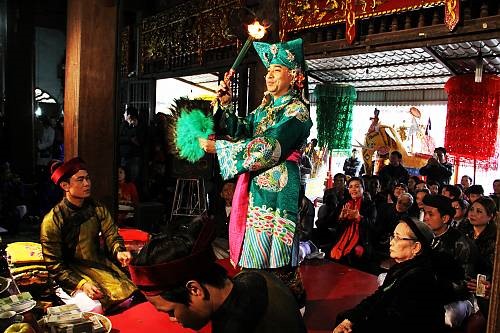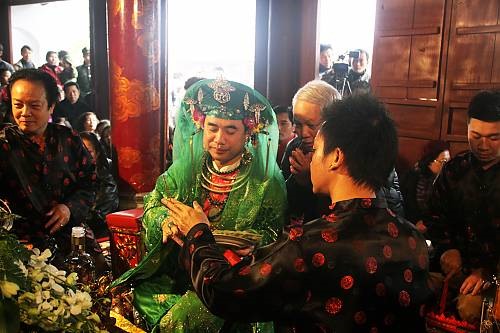 Life & Style
Life & Style

The UNESCO's recognition that Mother Goddesses of the three Realms as now intangble cultural heritage of humanity urged Vietnamese people and cultural managers to preserve and promote the heritage.
 |
| Spiritual conduit: A medium performs in a ritual dedicated to the Mother Goddess of Forests. There are 36 spirit incarnations, and each spirit has its own costume, dance, songs and offerings. — Photo courtesy Việt Nam National Institute of Culture and Arts Studies |
HÀ NỘI — The ancient Vietnamese tradition of Worshipping Mother Goddesses has been recognised as an Intangible Cultural Heritage of Humanity by UNESCO.
The recognition will motivate the Vietnamese people and its cultural mandarins to preserve and promote the tradition, said, Phạm Sanh Châu, Secretary General of Việt Nam National Commission for UNESCO, losing no time in sharing the good news on his Facebook page.
Châu led a Vietnamese delegation to submit the dossier on Worshipping the Mother Goddesses at the 11th Conference of the Inter-governmental Committee for the Safeguarding of Intangible Cultural Heritage. The meeting took place at Addis Ababa, Ethiopia from November 28 to December 3.
The dossier indicated that the tradition satisfies all criteria for the recognition. It has been passed through generations, is constantly recreated by communities and groups in response to their environment, and it provides communities and groups involved with ‘a sense of identity and continuity’.
Nguyễn Thế Hùng, head of the Department of Cultural Heritage, said many researchers and believers contributed to the dossier.
“The practice of shared values and strong belief in the compassion and grace of the Mother Goddesses provides a basis for social relations, connecting members of participating communities,” he said.
“Worship of the Mother Goddesses also contributes to the appreciation of women and their role in society,” he added.
Belief in the deities originated in various regions of the country and among different ethnic groups, reflecting the country’s cultural diversity as well as cultural exchages between different communities, he said.
The Three Realms in this tradition are heaven, water, and mountains and forests. The Mother Goddesses include Liễu Hạnh (a nymph who descended to Earth, lived as a human and became a Buddhist nun) referred to as the Mother of the World, and other spirits considered legendary heroes.
Practitioners of the worshipping tradition include temple guardians, ritual priests, spirit mediums, mediums’ assistants, musicians who perform the songs for the spirits, disciples and lay adherents who share the same beliefs in the spiritual power, supernatural strength and protection of the pantheon of Mother Goddesses.
The guardians take care of the temples, offer daily incense and flowers to spirits, instruct worshippers and pilgrims in ritual acts and play an active role in organising spirit possession rituals and festivals. Many guardians inherit their position from their families.
Priests perform ceremonies, which involve conveying the wishes of the devotees and communities to the Mother Goddesses and spirits through prayer and petition sheets. The ritual expertise of male priests is usually passed down to sons or disciples.
Male and female spirit mediums are initiated before performing the spirit possession rituals at the temples. Each spirit possession ritual consists of 5-36 spirit incarnations, and each spirit has its own costume, dance, songs and offerings.
Throughout the spirit possession rituals a band of musicians perform the songs for spirits. Bands usually have between two and five musicians.
The tradition of worshipping the Mother Goddesses dates back to the 16th century.
Activities associated with the tradition help maintain the community’s history, cultural heritage and identity.
Apart from Việt Nam’s Worship of the Mother Goddess, 11 other additions to the Representative List of Intangible Cultural Heritage.
They are Bhojpuri folk songs in Mauritius; Geet-Gawai, Mexico Charreria, equestrian tradition; Argungu international fishing and cultural festival in Nigeria; Carnival of El Callao in Venezuela; Switzerland Winegrowers’ Festival in Vevey; traditional wall-carpet craftsmanship in Romania; Czechia puppetry; Skofja Loka passion play in Slovenia; and Palov culture and tradition in Uzbekistan. — VNS
 |
| Ready to receive:A male medium (centre) prepares for the spirit possession ritual at the temples. — Photo courtesy Việt Nam National Institute of Culture and Arts Studies |
 |
| Elementary: Statues of Mother Goddess of three Realms include heaven (centre), water (right), and mountains and forests (left). — Photo courtesy Việt Nam National Institute of Culture and Arts Studies |




